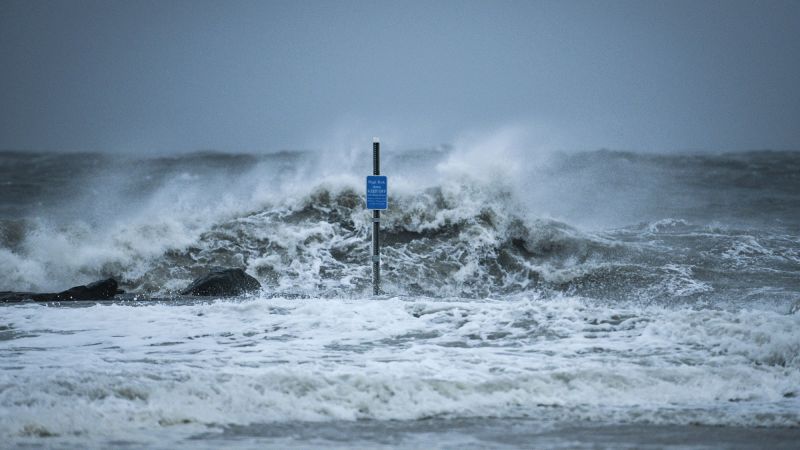Crucial Ocean Current System Slowdown Impacts US Coastlines

Welcome to your ultimate source for breaking news, trending updates, and in-depth stories from around the world. Whether it's politics, technology, entertainment, sports, or lifestyle, we bring you real-time updates that keep you informed and ahead of the curve.
Our team works tirelessly to ensure you never miss a moment. From the latest developments in global events to the most talked-about topics on social media, our news platform is designed to deliver accurate and timely information, all in one place.
Stay in the know and join thousands of readers who trust us for reliable, up-to-date content. Explore our expertly curated articles and dive deeper into the stories that matter to you. Visit Best Website now and be part of the conversation. Don't miss out on the headlines that shape our world!
Table of Contents
Crucial Ocean Current System Slowdown Impacts US Coastlines: A Warning Sign?
The Atlantic Meridional Overturning Circulation (AMOC), a crucial ocean current system often described as the "engine" of the Atlantic, is showing signs of significant slowdown, raising concerns about potentially devastating impacts on US coastlines and global weather patterns. This isn't just a distant threat; the implications are far-reaching and demand immediate attention. Scientists are increasingly worried about the potential consequences, ranging from rising sea levels to more extreme weather events.
What is the AMOC and Why is its Slowdown Concerning?
The AMOC is a vast system of ocean currents that transports warm water from the tropics northward towards the North Atlantic, and cold water southward. This intricate system plays a vital role in regulating global climate, influencing weather patterns across North America and Europe. A slowdown in the AMOC could have cascading effects on the entire planet. Think of it like a massive conveyor belt; if it slows down, the distribution of heat and salinity across the ocean is disrupted.
Evidence of Slowdown and Potential Causes:
Recent studies utilizing various data sources, including satellite observations and oceanographic measurements, strongly suggest a weakening of the AMOC. While the exact extent of the slowdown is still debated within the scientific community, the trend is undeniable. Several factors contribute to this concerning development:
- Melting glaciers and ice sheets: The influx of freshwater from melting ice reduces the salinity of the North Atlantic, hindering the sinking of cold, dense water – a crucial driver of the AMOC.
- Climate change: Rising global temperatures are altering ocean currents and stratification, further impacting the AMOC’s stability. This is linked to increased atmospheric greenhouse gas concentrations, a direct result of human activities.
- Natural variability: While anthropogenic factors are widely believed to be the primary drivers, natural variations in the climate system also play a role. Distinguishing between these natural fluctuations and long-term trends driven by climate change remains a complex challenge for scientists.
Impact on US Coastlines:
A weakening AMOC poses several serious threats to US coastlines:
- Sea level rise: A slowdown could lead to accelerated sea level rise along the eastern coast of the US, increasing the risk of coastal flooding and erosion. This is particularly concerning for densely populated coastal communities.
- Increased storm intensity: Changes in ocean currents can influence atmospheric circulation patterns, potentially leading to more frequent and intense hurricanes and nor'easters impacting the Atlantic coast.
- Changes in marine ecosystems: Alterations in water temperature and salinity affect marine life, potentially disrupting fisheries and impacting coastal economies reliant on healthy ocean ecosystems.
What Can We Do?
Addressing the slowdown of the AMOC requires a multifaceted approach focusing on mitigating climate change. This includes:
- Reducing greenhouse gas emissions: Transitioning to renewable energy sources and improving energy efficiency are crucial to slowing down global warming and its impact on ocean currents.
- Protecting and restoring coastal ecosystems: Healthy coastal ecosystems, like mangroves and salt marshes, act as natural buffers against sea level rise and storm surges.
- Investing in research: Continued research is essential to better understand the intricacies of the AMOC, predict future changes, and develop effective adaptation strategies.
The slowdown of the AMOC is a stark warning of the far-reaching consequences of climate change. Urgent action is needed to reduce emissions, protect our coastlines, and secure a sustainable future for generations to come. The future of our coastal communities depends on it. Learn more about the AMOC and its impact by exploring resources from the NOAA and NASA.

Thank you for visiting our website, your trusted source for the latest updates and in-depth coverage on Crucial Ocean Current System Slowdown Impacts US Coastlines. We're committed to keeping you informed with timely and accurate information to meet your curiosity and needs.
If you have any questions, suggestions, or feedback, we'd love to hear from you. Your insights are valuable to us and help us improve to serve you better. Feel free to reach out through our contact page.
Don't forget to bookmark our website and check back regularly for the latest headlines and trending topics. See you next time, and thank you for being part of our growing community!
Featured Posts
-
 Tom Cruise And Ana De Armas New Movie Review And Relationship Speculation
May 18, 2025
Tom Cruise And Ana De Armas New Movie Review And Relationship Speculation
May 18, 2025 -
 Beyond The Velvet Rope Analyzing Red Carpet Guest Violations
May 18, 2025
Beyond The Velvet Rope Analyzing Red Carpet Guest Violations
May 18, 2025 -
 Australian Man Sentenced To 13 Years In Russian Prison For Fighting In Ukraine
May 18, 2025
Australian Man Sentenced To 13 Years In Russian Prison For Fighting In Ukraine
May 18, 2025 -
 Dodgers Roster Move Pitcher Promoted From Oklahoma City Triple A
May 18, 2025
Dodgers Roster Move Pitcher Promoted From Oklahoma City Triple A
May 18, 2025 -
 Top Picks Films And Tv For Your Graduation Weekend
May 18, 2025
Top Picks Films And Tv For Your Graduation Weekend
May 18, 2025
Latest Posts
-
 Graduate Weekend The Best Shows And Movies To Watch
May 19, 2025
Graduate Weekend The Best Shows And Movies To Watch
May 19, 2025 -
 Extradition To Japan Uk Citizens Involved In Tokyo Jewellery Theft
May 19, 2025
Extradition To Japan Uk Citizens Involved In Tokyo Jewellery Theft
May 19, 2025 -
 Cannes Through A Retro Lens Unexpected And Ludicrous Pictures From The Past
May 19, 2025
Cannes Through A Retro Lens Unexpected And Ludicrous Pictures From The Past
May 19, 2025 -
 Government Announces Revised Eu Agreement And Winter Fuel Payment U Turn
May 19, 2025
Government Announces Revised Eu Agreement And Winter Fuel Payment U Turn
May 19, 2025 -
 The Unfiltered Cannes Funny And Absurd Images From Before The Smartphone Era
May 19, 2025
The Unfiltered Cannes Funny And Absurd Images From Before The Smartphone Era
May 19, 2025
